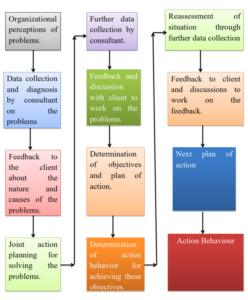OD Process
OD is concerned with a long term plan for improving an organization’s overall effectiveness. In view of modern management theory and practice, the following stages can be suggested in OD process:
1. Problem identification and diagnosis
OD programme starts with the identification of problems in the organization. Analysis of various symptoms both overt and covert may help in identifying the problems. Diagnosis gives correct identification of a problem and its causes and determines the scope of future course of action. Diagnosis in OD involves a number of techniques concerned with identifying concerns and issues, establishing priorities and translating them into aims and objectives. Once problem is identified, the analysts will show why the problem exists. The analyst will identify the variables that can be altered or changed by the organization and its management, such as leadership styles, organization structure, organizational objective, etc.
2. Planning strategy for change
When problems are diagnosed the OD practitioner either consultant or management plans the various courses of action. Attempts are made to transform diagnosis of the problem into a proper action plan involving the overall goals for change, determination of the basic approach for attaining these goals, and the sequence of detailed scheme for implementing the approach. Although it is a relatively simple matter to identify changes after they have occurred, it is considerably more difficult to influence the direction thrust of changes while they are under way. Thus planning and implementation of change are interdependent, the way in which change is planned has an impact on the way in which it is carried out, and conversely, the problems of implementing change have an impact on the way in which it is planned.
3. Intervening in the system
Intervening in the system refers to implementation of the planned activities during the course of an OD programme. These planned activities bring certain change in the system which is the basic objective of OD. There may be various methods through which external consultant intervenes in the system.
4. Evaluation
Evaluation stage consists of measuring the degree of success of OD intervention. Once OD programme is successfully implemented, the change agent must evaluate the effectiveness of the programme. This stage is concerned with post-intervention actions. It mainly involves evaluation, feedback and corrective actions. It shows how far OD intervention is successful and what is needed to be done to modify the programme.
Many Indian companies, including ITC, M&M, L &T, Google India, LIC, SBI, HUL and some others, follow more or less the same OD processes. Many of them maintain well- equipped OD departments for pursuing continuous development activities.
Action Research model of OD
The action research refers to a change process based on systematic collection of data and then selection of action plan based on what the analysis of data indicates. The OD process can be conveniently presented in the form of action research. OD emphasizes the process of problem solving and traits the participants to identify and solve problems that are important to them. For this purpose various steps of OD are undertaken on continuous and cyclical basis. This cyclical process of using research to guide action, which generates new data as the basis for new actions, is known as action research. Carious activities involved in action research are presented in the figure below:
The model involves data collection and diagnosis, providing feedback to client and discussion and determination of action at various stages, Action research is the basis for designing strategies for OD, Specifically, it is important in the following context:
1. It involves all those who take action or who are affected by change in the organization. Therefore chances of willing acceptance of change are quite high.
2. It helps the members of a group to work together effectively and to develop way for emotional and philosophical adjustments to change.
3. It rationalizes the action by providing accurate knowledge of the context in which it occurs.

